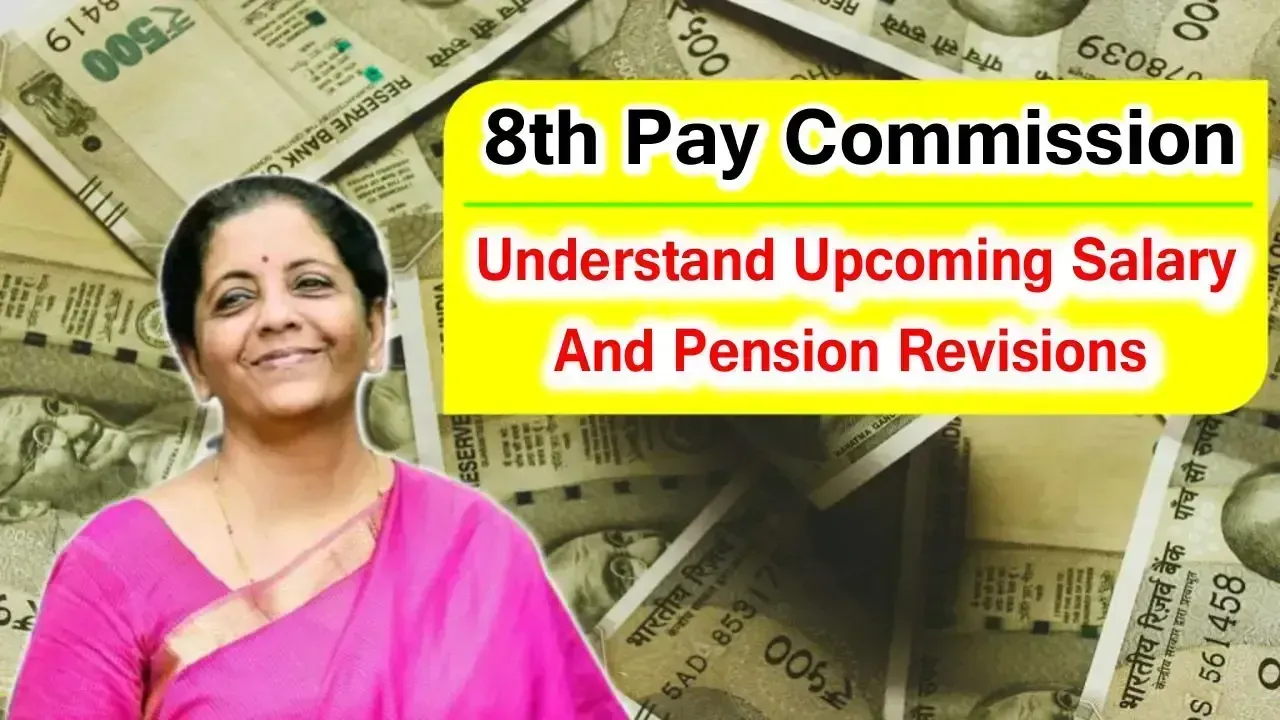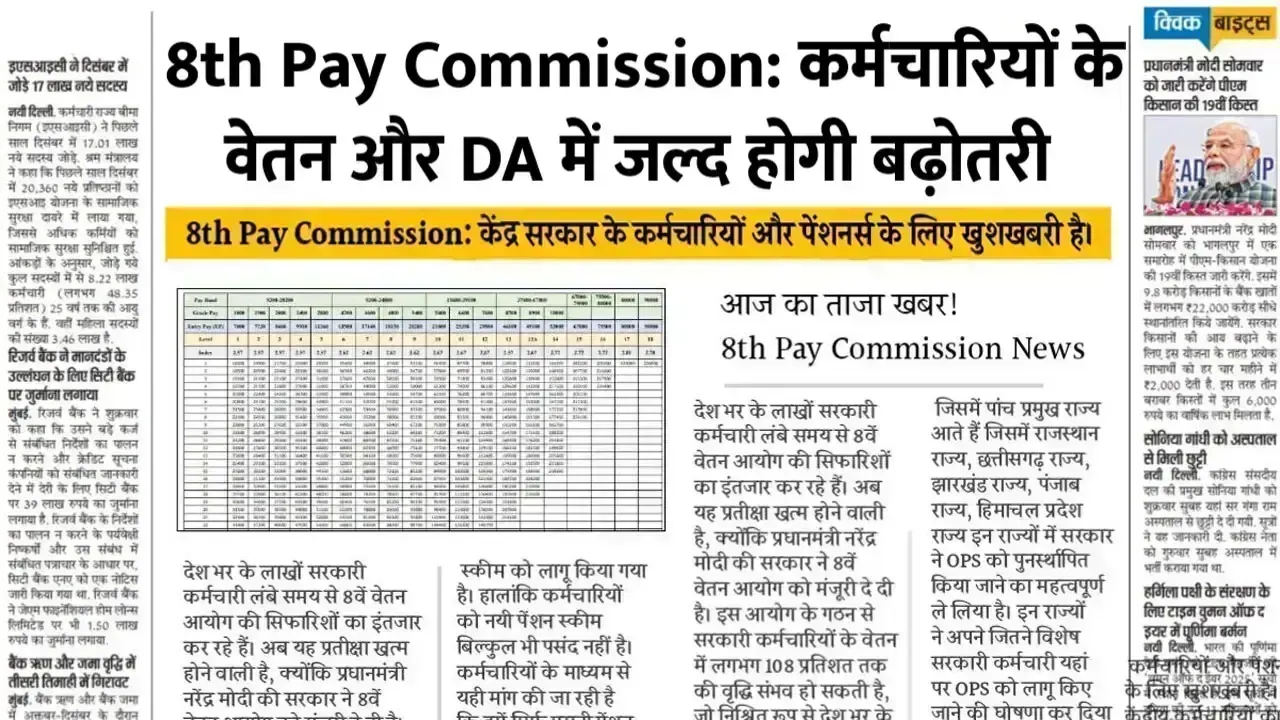8th Pay Commission, Understand Upcoming Salary and Pension Revisions
8th Pay Commission, Understand Upcoming Salary and Pension Revisions: The Government of India has officially initiated the process to constitute the 8th Central Pay Commission (CPC), marking a significant milestone in the restructuring of pay, pensions, and allowances for government employees across the country.
This step is expected to bring far-reaching changes that will impact millions of central and state government employees, as well as a large number of pensioners. With the cost of living consistently on the rise and inflation affecting daily household expenses, there is a growing need for timely wage revisions that reflect present economic realities.
The formation of the 8th CPC comes at a critical juncture and is anticipated to address long-standing concerns regarding stagnant salary structures and outdated pension norms. By aligning government compensation packages with current financial demands, the commission’s recommendations are likely to provide much-needed financial relief and stability to employees and retirees alike.

As the commission begins its work, expectations are high for a comprehensive overhaul that acknowledges the invaluable service of public sector workers while ensuring their economic well-being. The new pay commission is not just a revision of numbers—it is a step towards restoring balance and fairness in government remuneration systems.
What is the 8th Pay Commission?
The Central Pay Commission is established every ten years to review and recommend revisions in the salary and pension structures of public sector employees. The upcoming 8th Pay Commission is set to play a significant role in determining the future financial framework for over 50 lakh government employees and approximately 65 lakh pensioners. Its primary task will be to evaluate the current pay structure and suggest updates that align with the prevailing economic scenario.
The 8th Central Pay Commission has already received official approval and is scheduled to begin its work from 1st January 2026. The implementation of its recommendations is expected by early 2027. Once enforced, eligible employees and pensioners are likely to receive arrears for the 12-month period starting from the effective date.
Expected Changes in Salary Structure
Fitment Factor to Drive Pay Hike
The fitment factor is a fixed multiplier that helps calculate revised salaries from the current basic pay. It’s one of the most awaited aspects of any pay commission as it directly impacts take-home salaries.
- Proposed Fitment Factor Range: Between 2.28 to 2.86
Here’s how this might translate to actual salaries:
| Pay Level | Current Basic Pay | Estimated Basic Pay (2.28 Factor) | Estimated Basic Pay (2.86 Factor) |
|---|---|---|---|
| Level 1 | ₹18,000 | ₹41,040 | ₹51,480 |
| Level 2 | ₹19,900 | ₹45,372 | ₹56,914 |
These are only indicative figures based on expected multipliers.
Pension Benefits Under the 8th Central Pay Commission (CPC)
Pensioners, particularly those who fall under the pre-2016 pay structure, are set to see a significant increase in their monthly pensions once the recommendations of the 8th CPC are fully implemented. This change will offer relief and financial security to pensioners across various categories.
Proposed Unified Pension Scheme
A new pension structure, commonly known as the Unified Pension Scheme, is currently being considered. The aim of this scheme is to standardize the calculation of pensions, ensuring consistency across different categories of pensioners and across various retirement timelines. This would streamline the pension system, making it more equitable and easier to manage.
Key Points for Pensioners
- Minimum Pension Increase: The minimum pension could increase significantly from the current ₹9,000 to around ₹25,740, marking a rise of approximately 186%.
- Average-Based Pension Calculation: The pension may be recalculated based on the average basic pay of the last 12 months prior to retirement, offering a more accurate assessment.
- Service-Based Pension Benefits: Employees with 25 years of service might be entitled to a pension that is equivalent to 50% of their average monthly basic pay, ensuring better financial security post-retirement.
Eligibility for Pension Revisions
Employees who retire prior to 1 January 2026 will also be entitled to revised pension benefits. The government has confirmed that all pensioners, regardless of whether they retired before or after the effective date, will receive the updated benefits under the 8th Central Pay Commission (CPC).
Revision of Allowances and Benefits
Pay revision alone doesn’t fully capture the impact of a pay commission, as allowances represent a significant portion of a government employee's overall earnings.
Dearness Allowance (DA)
In the upcoming pay revision, the accumulated Dearness Allowance (DA) may be merged with the basic pay before applying the new fitment factor. This approach, which has been followed in previous pay commissions, is intended to simplify the implementation of the new pay matrix.
House Rent Allowance (HRA)
With the expected increase in basic pay, House Rent Allowance (HRA) is also anticipated to rise accordingly. The city classification into categories X, Y, and Z will continue to determine the level of HRA based on the location of the employee.
Transport Allowance (TA)
Transport Allowance (TA) is likely to be revised considering factors such as inflation trends and commuting costs. It’s expected that the allowances for metro and non-metro areas may experience different levels of increase based on these factors.
Implementation Phases
The implementation of the revised pay structure will follow these key stages:
- Commission Formation and Terms of Reference (ToR): The government appoints a chairman and defines the scope and objectives of the commission.
- Data Analysis and Public Feedback: The commission gathers data from ministries, departments, and employee unions, as well as solicits public feedback to inform its recommendations.
- Recommendation Drafting: After a detailed study, the commission formulates proposals for pay revision, allowances, and other related adjustments.
- Submission and Approval: The final report is submitted to the government for review and approval.
- Notification and Execution: Once approved, the new pay structure is officially rolled out, with employees receiving their retrospective arrears from the effective date.
How Will Employees Be Impacted?
Central Government Employees:
- Substantial increase in both gross salary and in-hand salary.
- Revised allowances such as HRA, TA, and other benefits will be adjusted according to the new pay matrix.
- A one-time payment of arrears is expected to be made upon the implementation of the revised pay structure.
State Government Employees:
- State governments typically implement the recommendations of the Central Pay Commission (CPC) after receiving approval from the central government.
- The timeline and specifics of the benefits may vary across different states.
Common Questions and Concerns
Will all employees receive arrears?
Yes, all eligible employees and pensioners will receive arrears, with the effective date set for 1 January 2026.
Will state governments immediately implement the 8th CPC recommendations?
Some states will adopt the changes promptly, while others may take additional time depending on their financial capacity and other considerations.
What about employees retiring before 2026?
Employees retiring before 2026 will not be excluded. The revised pension scheme will apply to all eligible retirees, ensuring that the new benefits are provided to them as well.
The 8th Pay Commission promises a financially brighter future for both central and state government employees, as well as pensioners. With projections suggesting significant increases in salary, pensions, and allowances, anticipation for the commission’s recommendations is high. While final figures and exact timelines will be clarified closer to 2026, employees are encouraged to stay updated through official channels to prepare for changes that could greatly benefit their financial planning and post-retirement security.
This new pay commission aims to establish fairness and parity across all departments and demonstrates the government's ongoing commitment to improving the livelihood of its workforce.



